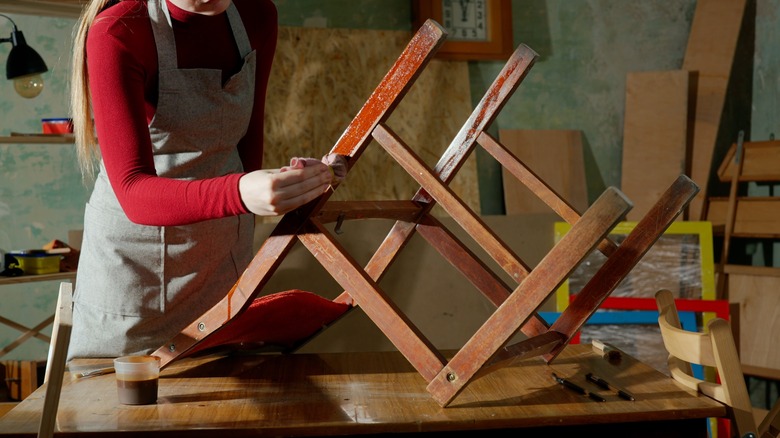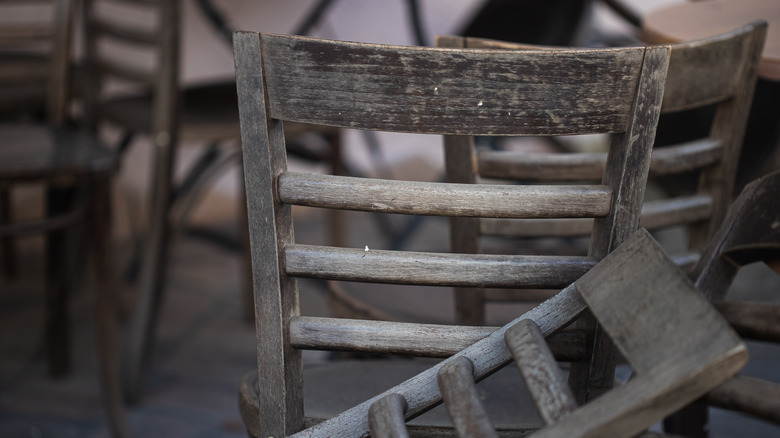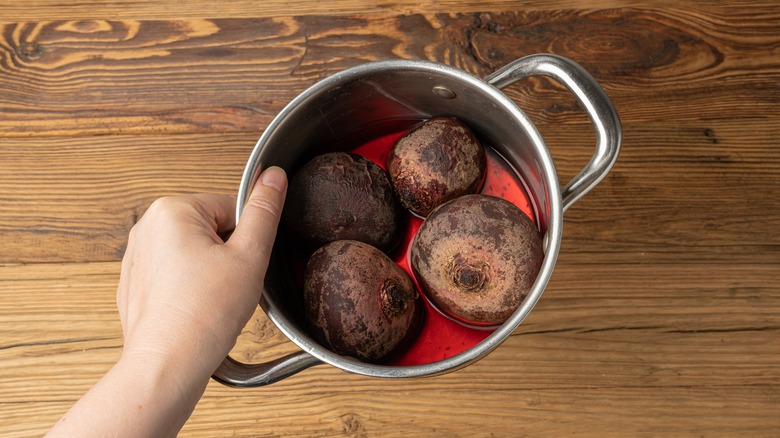The Bizarre Beet Juice Hack People Use To Stain Wood (& Does It Actually Work?)
You've had that woodworking project sitting in your workshop for way too long. What's stopping you is the fact you've run out of your favorite vibrant red wood stain. Instead of taking a trip to the store, it might be worth rummaging around in the bottom of your pantry for a long-forgotten can of beet slices. Yup, that's right. Beetroot juice is lauded by some as a truly beautiful wood stain. Detractors, however, state that natural timber dyes just aren't that durable. We say, however, that beetroot juice wood stain is, at the very least, worth testing, especially if you gravitate toward natural alternatives or are staining woodcrafts destined to be used outdoors (say, in the garden) or in a child's or pet's playroom.
Many DIYers are interested in ingredients you can use to naturally stain wood because they've heard negative things about commercial options — namely that they contain petroleum and chemical solvents that emit toxic fumes and are flammable. By contrast, natural finishes are considered practically harmless for humans and the environment. Fresh or even canned beets are simply root vegetables, after all. Any unwanted staining they cause in other settings is the entire point in this case. Plus, natural wood stain enthusiasts praise the surprising range of vibrant colors plants provide — bright Barbie pink to deep red in the case of beetroot. They also go on the wood smoothly, easily, and quickly, whereas commercial alternatives apply notoriously unevenly without careful preparation.
The pros outweigh the cons for beet juice wood stain
Naysayers state that the color of a beet dye fades or mellows over time faster than, say, oil-based commercial counterparts. It's not untrue, and is especially evident when beetroot-tinted furniture is used outdoors. The issue is thought to be due to exposure to sunlight. However, research published in Maderas. Ciencia y Tecnología in 2015 found wood specimens stained with beetroot extract held color longer than synthetic-dyed wood when exposed to UV radiation. Practically, add 1 teaspoon of alum (potassium aluminum sulfate) to each gallon of beetroot juice, which acts as a mordant, helping the wood retain the color longer. Or, simply paint on successive layers of stain to build the color.
Beet juice stain — or homemade natural wood dyes, in general — is also thought not to be as durable as store-bought options. Outside of the aforementioned fading, beetroot stain may leave wood more vulnerable to harm, such as water infiltration (even the types of wood that will hold up to the humidity in your bathroom), scratching, and denting. Plus, the water content in the beet juice might cause thin strips of wood to warp. In fact, another more recent study published in Maderas. Ciencia y Tecnología found that plant-based wood dyes, including beet, added to lacquer coatings excelled in all areas of durability outside of scratch resistance. At worst, you may have to re-apply the beet juice more often than you'd like — say, in just a few years.
Make and apply beet juice wood stain to your next project
Making this stain can be as straightforward as using the juice from a freshly opened can of sliced beets or rubbing wood with fresh-cut slices. Better yet, soak chopped beetroot in a container of white vinegar overnight, boil the beets in water for about an hour (let the mixture cool to room temperature), and run fresh beets through a juicer for a richer hue. Strain the beet mixture through a filter. If the liquid feels thin, add a little white flour to thicken it. Store it in a sterilized lidded jar. Alternatively, pulverize the beetroot into a paste and apply that directly to your wood, then wipe it off later.
A helpful tip savvy DIYers will want to know before using wood stain, especially of the natural variety, is that you need to carefully prepare the timber by lightly sanding it (it's okay if the surface remains a little rough), then spraying it with water. This will raise the wood grain, resulting in a stronger colored stain and better penetration. To stain your wood object, apply the beetroot juice to the surface in even strokes using a large paintbrush or clean cloth. Let each layer dry before applying the next — the hue will increase in vibrancy with more coats. Let the stained wood dry completely for up to 36 hours, then apply a top coat or sealer of unrefined walnut oil, polyurethane or shellac-based sanding sealer, or acrylic lacquer.


